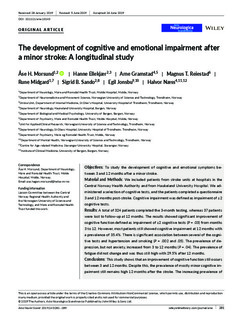| dc.contributor.author | Morsund, Åse Hagen | |
| dc.contributor.author | Ellekjær, Hanne | |
| dc.contributor.author | Gramstad, Arne | |
| dc.contributor.author | Reiestad, Magnus Tallaksen | |
| dc.contributor.author | Midgard, Rune | |
| dc.contributor.author | Sando, Sigrid Botne | |
| dc.contributor.author | Jonsbu, Egil | |
| dc.contributor.author | Næss, Halvor | |
| dc.date.accessioned | 2019-12-16T12:56:07Z | |
| dc.date.available | 2019-12-16T12:56:07Z | |
| dc.date.created | 2019-10-13T13:10:47Z | |
| dc.date.issued | 2019 | |
| dc.identifier.citation | Acta Neurologica Scandinavica. 2019, 140 (4), 281-289. | nb_NO |
| dc.identifier.issn | 0001-6314 | |
| dc.identifier.uri | http://hdl.handle.net/11250/2633424 | |
| dc.description.abstract | Objectives
To study the development of cognitive and emotional symptoms between 3 and 12 months after a minor stroke.
Material and Methods
We included patients from stroke units at hospitals in the Central Norway Health Authority and from Haukeland University Hospital. We administered a selection of cognitive tests, and the patients completed a questionnaire 3 and 12 months post‐stroke. Cognitive impairment was defined as impairment of ≥2 cognitive tests.
Results
A total of 324 patients completed the 3‐month testing, whereas 37 patients were lost to follow‐up at 12 months. The results showed significant improvement of cognitive function defined as impairment of ≥2 cognitive tests (P = .03) from months 3 to 12. However, most patients still showed cognitive impairment at 12 months with a prevalence of 35.4%. There is significant association between several of the cognitive tests and hypertension and smoking (P = .002 and .05). The prevalence of depression, but not anxiety, increased from 3 to 12 months (P = .04). The prevalence of fatigue did not change and was thus still high with 29.5% after 12 months.
Conclusions
This study shows that an improvement of cognitive function still occurs between 3 and 12 months. Despite this, the prevalence of mostly minor cognitive impairment still remains high 12 months after the stroke. The increasing prevalence of depressive symptoms highlights the importance of being vigilant of depressive symptoms throughout the rehabilitation period. Furthermore, high prevalence of fatigue persisted. | nb_NO |
| dc.language.iso | eng | nb_NO |
| dc.publisher | Wiley | nb_NO |
| dc.rights | Navngivelse 4.0 Internasjonal | * |
| dc.rights | Navngivelse-Ikkekommersiell 4.0 Internasjonal | * |
| dc.rights.uri | http://creativecommons.org/licenses/by-nc/4.0/deed.no | * |
| dc.title | The development of cognitive and emotional impairment after a minor stroke: A longitudinal study | nb_NO |
| dc.type | Journal article | nb_NO |
| dc.type | Peer reviewed | nb_NO |
| dc.description.version | publishedVersion | nb_NO |
| dc.source.pagenumber | 281-289 | nb_NO |
| dc.source.volume | 140 | nb_NO |
| dc.source.journal | Acta Neurologica Scandinavica | nb_NO |
| dc.source.issue | 4 | nb_NO |
| dc.identifier.doi | 10.1111/ane.13143 | |
| dc.identifier.cristin | 1736741 | |
| dc.description.localcode | This is an open access article under the terms of the Creative Commons Attribution‐NonCommercial License, which permits use, distribution and reproduction in any medium, provided the original work is properly cited and is not used for commercial purposes. © 2019 The Authors. Acta Neurologica Scandinavica Published by John Wiley & Sons Ltd | nb_NO |
| cristin.unitcode | 194,65,15,0 | |
| cristin.unitcode | 194,65,30,0 | |
| cristin.unitcode | 1920,15,0,0 | |
| cristin.unitcode | 194,65,0,0 | |
| cristin.unitcode | 1920,16,0,0 | |
| cristin.unitcode | 194,65,35,0 | |
| cristin.unitname | Institutt for klinisk og molekylær medisin | |
| cristin.unitname | Institutt for nevromedisin og bevegelsesvitenskap | |
| cristin.unitname | Medisinsk klinikk | |
| cristin.unitname | Fakultet for medisin og helsevitenskap | |
| cristin.unitname | Nevroklinikken | |
| cristin.unitname | Institutt for psykisk helse | |
| cristin.ispublished | true | |
| cristin.fulltext | original | |
| cristin.qualitycode | 1 | |

